Dance photography is a fascinating genre that can turn even the simplest movements into art.
Here are 14 tips to help you easily capture the beauty of any dancing style.
14. Explore Dance Photography Through Getting to Know the Dancer(s)

One of the best ways to understand someone is to talk to them about their passion.
Instead of blindly going into a photoshoot, find out who your model is and why they love dancing. Let them know why you’re interested in dance photography, too.
Once you get to know each other, you’ll feel more relaxed and confident during your session.
This will allow you to make mistakes without feeling embarrassed. And it will give you enough room to experiment with different concepts.
13. Familiarise Yourself With the Dance Style

What type of dance are you going to photograph? If you answer this question in detail before your photo shoot, you’ll be able to predict your model’s movements and adjust your camera settings accordingly.
For example, if you want to get better at dance recital photography, you might want to use a wide-angle lens to take wider photos. If you want to take interesting close-ups while your model is dancing, you might need a zoom lens.
If you’ve never photographed a specific dance style before, watch a few videos or talk to the dance company before your shoot.
The more you know, the easier it will be for you to come up with cool ideas. These will not only impress your models but also put a spotlight on your skills.
12. Make Sure Your Models Know They’re Being Photographed

No, this doesn’t mean you have to shout at them as you quickly press the shutter. They just have to know that someone is going to take pictures of them as they dance.
Dance photography is quite similar to street photography when it comes to permission. If you’re going to photograph a group of strangers, you’ll have to get their permission first.
This will be easy to achieve if you work with a dance instructor who can inform the dancers about your presence. It won’t be as easy if you stumble upon a random group of dancers outdoors.
If you just want to practice, you can freely photograph strangers. But you have to be careful when it comes to online sharing and selling.
To avoid unwanted confrontation, get to know a few basic street photography laws.
11. Use a Tripod to Avoid Camera Shake

You might be tempted to move your camera around all the time to get the perfect shot of a dancer’s graceful movements. This might confuse or frustrate you, especially during a fast-paced dance event.
To avoid unnecessary stress and camera shake, use a tripod. By limiting your movements, you’ll be able to make the most of the compositions in front of you.
A tripod will also help you take beautiful long exposure photos (you’ll find out more about this topic soon) that will fill your gallery with diversity and surrealism.
10. But Don’t Take Photos from One Angle All the Time

If you constantly shoot from a standing or sitting point of view, your photos will look dull. You can easily change this by shooting from different angles.
If you want to make your photos stand out even more, create depth using foregrounds. For example, if you photograph a dancer through a fence, you’ll add both texture and depth to your photo.
Don’t be afraid of experimenting with different objects and foregrounds. The more you practice, the more interesting your compositions will look.
9. Shoot on a Real Stage
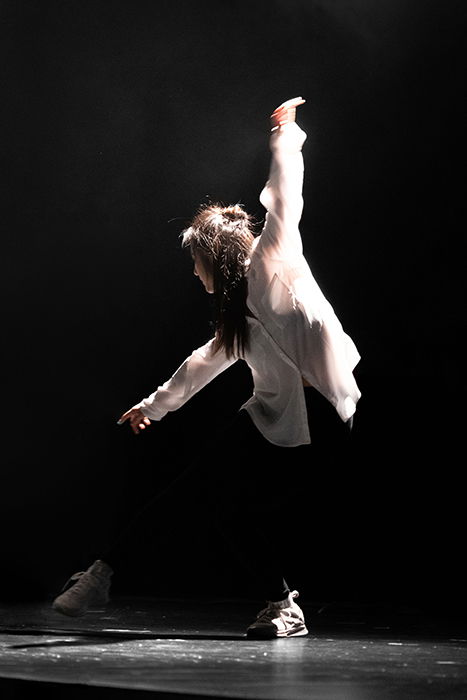
If your model spends a lot of time on a stage, take photos there!
A stage already has all the equipment you need to photograph professional dancers. The black background will put the focus on your dancer and the natural or artificial light will create a photo-worthy atmosphere.
All you’ll need to do is focus on your dancer and your camera settings.
In addition to providing you with tools, a stage will make your model feel at home. This will enable them to feel more confident and powerful in front of your camera.
8. Use Long Exposure to Elegantly Track Movements

In some photography genres, sharpness is a priority. When it comes to good dance photographs, this isn’t always the case.
Long exposure is often used in landscape photography to emphasise certain movements, like running water or a windswept tree.
Dance photographers can use it in a similar way to photograph body movements. This is why it’s worth memorising the various guidelines of long exposure.
7. Use Dramatic Lighting
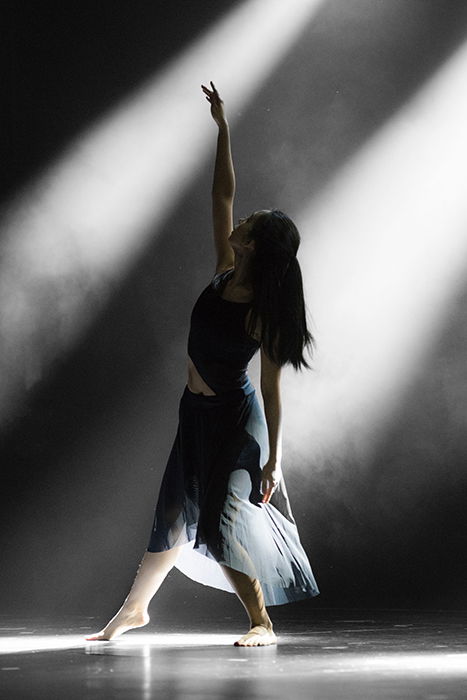
Dancers don’t always have to be photographed outdoors or on a stage. You can use simple locations with dramatic lighting to take unique photos of your models.
An empty white room with window blinds on a sunny day, a roof during the golden hour, and a dance studio with artificial light. These can all be used to create dramatic compositions that emphasise the dancer’s movements.
6. Take Photos at Dancing Events

Not sure what kind of dancers you want to photograph? You can introduce yourself to different dance styles by taking photos at events or recitals.
Once you get permission to photograph the dancers, you can significantly improve your knowledge of dance, portrait, and even candid photography.
Even a couple of hours at a recital will expose you to different styles, movements, and lighting situations. Use this opportunity to experiment with different angles, fast shutter speeds, and apertures.
All of this exposure will give you a better idea of the type of dance photography you should pursue. It will also teach you how to make the most of a busy setting.
5. Use a Large Aperture to Separate the Dancer from the Background
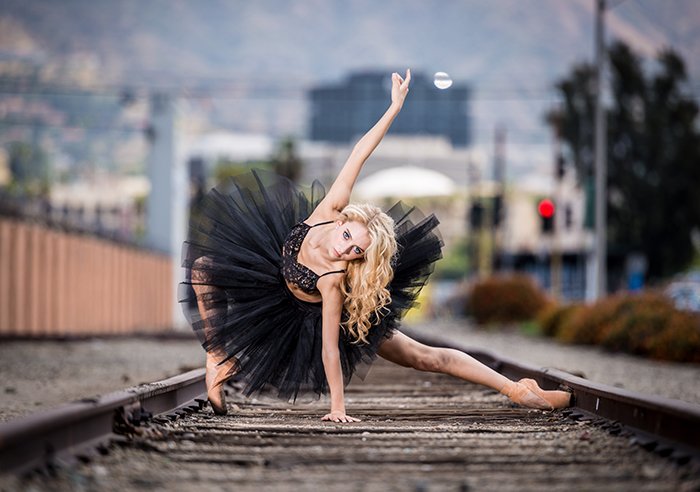
Dancers aren’t always surrounded by beautiful backgrounds. Sometimes, they’re surrounded by curious strangers, unflattering buildings, or a street full of cars.
All of these distractions can make it difficult to focus solely on one subject. Photography projects showcasing ballet dancers in urban settings are popular still.
If you can’t move to another location, you can separate your subject from their background by using a large aperture. A large aperture, also known as a small f-number, will add more depth to your photos. Examples of a large aperture are f/1.2 and f/2.8.
The larger your aperture, the blurrier your background will be. However, this might stop you from taking sharp photos.
If your aperture is too small, you might find it difficult to focus on specific parts of your model’s face. A relatively large aperture, such as f/2.0, will blur your backgrounds but also let you take sharp photos.
4. Focus on Details to Tell a Story
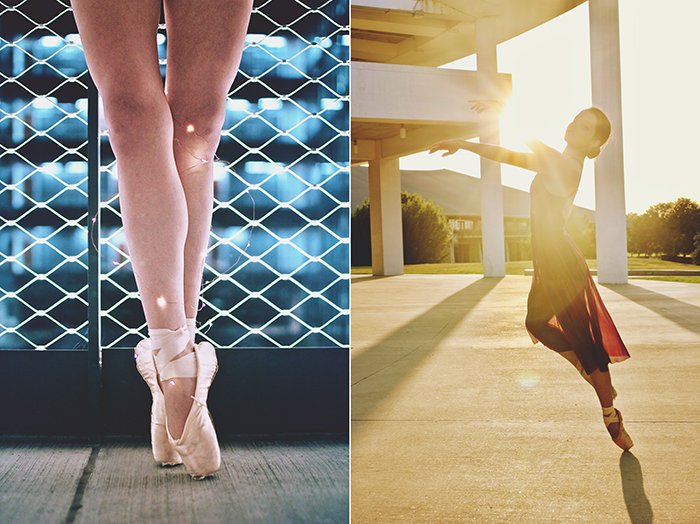
Details are just as important as the big picture in any photography genre. Even though wide shots are what make dance photography beautiful, they need to have a story to be meaningful.
Details can add depth, texture, and emotion to your photos. You can use them to create diptychs, which are collages that consist of two photos.
You can also include them in a set of photos inspired by the dancer(s) you’re working with.
3. Take Photos in Vibrant Places

Overly vibrant locations can take the spotlight away from your subject. However, if used correctly, they can dramatically enhance your compositions.
No matter what location you shoot in, make sure you use a large aperture to separate the dancer from their background.
The larger your aperture, the larger the background bokeh will be. This will make it easy for you to blur out almost any background distraction.
With the right amount of blur, you’ll be able to photograph your dancer in front of fantastic locations like carousels, cityscapes, and neon lights.
2. Photograph Multiple Dancers from Above
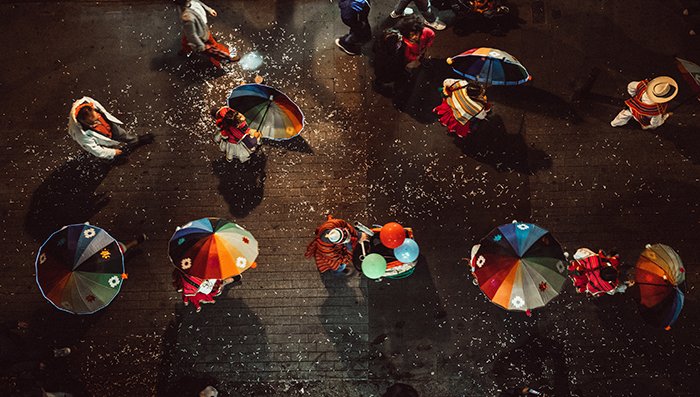
If you have to photograph multiple dancers, you can create symmetrical compositions by taking photos from above.
This is easiest to do in a dance theatre or any location with an indoor balcony.
This unique perspective will allow you to play around with different concepts and outfits, like the rainbow umbrellas in the photo above.
1. Take Surreal Photos of Dancers With Flour

Flour dance photography is a sub-genre that involves a lot of messiness and surrealism. You’ll need the following things to have a successful flour photo shoot:
- A black backdrop to highlight the whiteness of the flour,
- Lots of flour,
- Any kind of material to protect objects that shouldn’t be covered in flour,
- A fan or large window to prevent suffocation,
- A mop to clean everything up at the end of your photo shoot,
- A clean set of clothes for you and your model.
If you need some ideas or inspiration, check out Derrick Senior’s flour portraits.
Conclusion
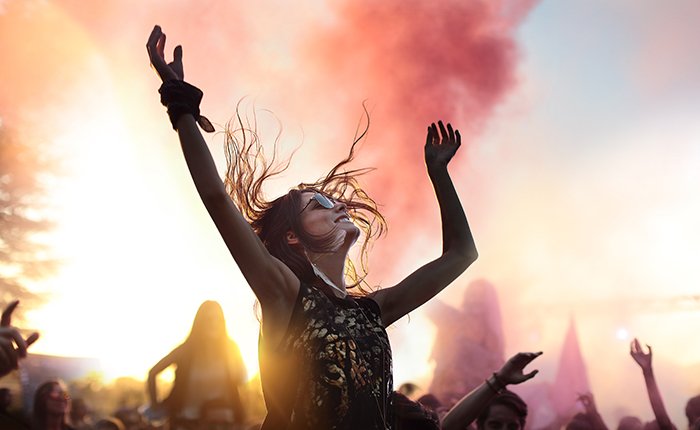
Dancing is freeing, vibrant, and eye-opening. You can use it to take photos that are just as emotional as your models.
With the right amount of practice, you’ll be able to photograph all kinds of dance styles, capture true joy, and take your photography skills to the next level.
If you’re looking for ideas to get started with dance photography, try a ballerina project.
Or call up your local dance company to see if they’re interested in some great dance photos. It’ll be good practise for you even if it’s unpaid!


